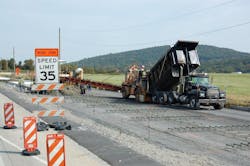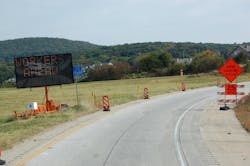Indeed, the annual analysis of the country’s roadways conducted by The Road Information Program (TRIP) group discerned that more than one-quarter (27%) of the nation's major urban roads – Interstates, freeways and other arterial routes – suffer from “substandard” pavement conditions that provide an unacceptably rough ride to motorists, costing the average urban driver $377 annually, or a total of $80 billion per year nationwide.
On top of that, an additional 27% of the nation’s major urban roads and highways have pavements that are in mediocre condition, 15% are in fair condition and 31% are in good condition, according to TRIP. Overall, including major rural roads, 14% of the nation’s major roads are in poor condition, 19% are in mediocre condition, 17% are in fair condition and 50% are in good condition.
[The Federal Highway Administration, however, believes that better “preventive maintenance” efforts can alleviate some of those conditions and produced the video below three years ago to illustrate that perspective.]
Yet the amount of money required to fix those problems while expanding our highway network to alleviate traffic congestion is staggering – some $1 trillion over the next two decades, according to Robert Poole, director of transportation policy at the Reason Foundation, with $600 billion dedicated just to rebuilding costs with a further $400 billion needed to add capacity.
And yes, despite several stories claiming that driving is trending downwards among younger Americans, TRIP and others still project vehicle travel to increase in the coming years – especially where freight hauling commercial vehicles are concerned.Overall vehicle travel increased by 37% from 1990 to 2011, TRIP said. While travel by large commercial trucks grew at an even faster rate – some 49% from 1990 to 2011. Vehicle travel is also expected to increase, TRIP added, by approximately 25% by 2030, with the level of heavy truck travel nationally anticipated to increase by approximately 64% over that 17 year period.
In the meantime, TRIP believes pavement conditions are likely to worsen as the current amount of funding by all levels of government is deemed inadequate. Through 2032, the group said in its report, the U.S. faces a $156 billion shortfall in the amount needed to maintain roadways in their current condition, a $374 billion shortfall to make modest improvements in pavement conditions and a $670 billion shortfall to make significant improvements to roadway conditions.
TRIP also pointed to a 2010 U.S. Department of Transportation report that determined the country would need to increase annual funding for road and highway improvements by 21% to keep them in their current condition, by 51% to make a modest improvement in overall conditions and by 91 percent to make significant improvement to their condition.“With state and local governments struggling to fund needed road repairs and with federal surface transportation funding set to be slashed next year, road conditions are projected to get even worse,” noted Will Wilkins, TRIP’s executive director, in the group’s report entitled Bumpy Roads Ahead: America’s Roughest Rides and Strategies to Make our Roads Smoother.
But where could such money come from? Higher fuel taxes? More highway tolls? And with the motoring public – much less the trucking community – happily and willingly fork over extra cash from their pockets via either of those methods?
The Reason Foundation’s Poole thinks that electronic tolling can generate the required funds with the least amount of fiscal intrusion into the driving lives of motorists and truckers.
In a report released by the group last month, Poole argued that in 37 of the 50 states in the U.S., revenues from modest toll rates would be sufficient to cover 90% or more of the costs associated with reconstructing and widening the Interstates. The baseline toll rates would be 3.5 cents per mile for cars and 14 cents a mile for trucks, with tolls indexed to inflation and adjusted annually.
Some states, though, like California, New York and Alaska, would require higher toll rates, as they would require more monies to deal with higher freight volumes. That’s why Poole thinks the costs of reconstructing urban Interstates would vary widely, ranging from a low of $315 million in Vermont to a high of $59 billion in California.
“The current transportation funding system is failing and won’t be able to rebuild or upgrade the Interstate system,” Poole stressed “This study shows that alternative financing, via all-electronic tolling, is a feasible way.“
However, Bud Wright, executive director of the American Association of State Highway and Transportation Officials (AASHTO), stresses that federal funding remains critical and cannot be ignored in terms of funding future transportation needs."States depend on investment from the Highway Trust Fund to help preserve and maintain the roads and bridges that carry our families and our economy,” he explained. “We cannot continue to ignore the very real crisis facing our national transportation system without a long-term, sustainable funding source for the Highway Trust Fund [as] federal dollars are a key source of transportation funding in many states.”
Yet funding only becomes a bigger issue as the main vehicle generating highway monies – the Moving Ahead for Progress in the 21st Century Act and known as “MAP-21” – expires on Sept. 30 next year.
Thus in the fall of 2014, nationwide federal funding for highways is expected to be cut back by almost 100% percent from the current $40 billion investment level unless additional revenues are provided to the federal Highway Trust Fund, due to a cash shortfall as projected by the Congressional Budget Office, Wright said.
No doubt more contentious debate is ahead on the subject of how to generate transportation funds for the future.




